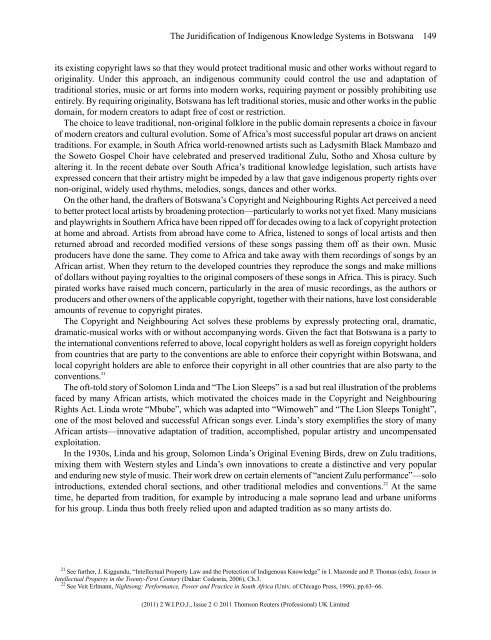WIPO Journal - World Intellectual Property Organization
WIPO Journal - World Intellectual Property Organization
WIPO Journal - World Intellectual Property Organization
Create successful ePaper yourself
Turn your PDF publications into a flip-book with our unique Google optimized e-Paper software.
The Juridification of Indigenous Knowledge Systems in Botswana 149<br />
its existing copyright laws so that they would protect traditional music and other works without regard to<br />
originality. Under this approach, an indigenous community could control the use and adaptation of<br />
traditional stories, music or art forms into modern works, requiring payment or possibly prohibiting use<br />
entirely. By requiring originality, Botswana has left traditional stories, music and other works in the public<br />
domain, for modern creators to adapt free of cost or restriction.<br />
The choice to leave traditional, non-original folklore in the public domain represents a choice in favour<br />
of modern creators and cultural evolution. Some of Africa’s most successful popular art draws on ancient<br />
traditions. For example, in South Africa world-renowned artists such as Ladysmith Black Mambazo and<br />
the Soweto Gospel Choir have celebrated and preserved traditional Zulu, Sotho and Xhosa culture by<br />
altering it. In the recent debate over South Africa’s traditional knowledge legislation, such artists have<br />
expressed concern that their artistry might be impeded by a law that gave indigenous property rights over<br />
non-original, widely used rhythms, melodies, songs, dances and other works.<br />
On the other hand, the drafters of Botswana’s Copyright and Neighbouring Rights Act perceived a need<br />
to better protect local artists by broadening protection—particularly to works not yet fixed. Many musicians<br />
and playwrights in Southern Africa have been ripped off for decades owing to a lack of copyright protection<br />
at home and abroad. Artists from abroad have come to Africa, listened to songs of local artists and then<br />
returned abroad and recorded modified versions of these songs passing them off as their own. Music<br />
producers have done the same. They come to Africa and take away with them recordings of songs by an<br />
African artist. When they return to the developed countries they reproduce the songs and make millions<br />
of dollars without paying royalties to the original composers of these songs in Africa. This is piracy. Such<br />
pirated works have raised much concern, particularly in the area of music recordings, as the authors or<br />
producers and other owners of the applicable copyright, together with their nations, have lost considerable<br />
amounts of revenue to copyright pirates.<br />
The Copyright and Neighbouring Act solves these problems by expressly protecting oral, dramatic,<br />
dramatic-musical works with or without accompanying words. Given the fact that Botswana is a party to<br />
the international conventions referred to above, local copyright holders as well as foreign copyright holders<br />
from countries that are party to the conventions are able to enforce their copyright within Botswana, and<br />
local copyright holders are able to enforce their copyright in all other countries that are also party to the<br />
conventions. 21<br />
The oft-told story of Solomon Linda and “The Lion Sleeps” is a sad but real illustration of the problems<br />
faced by many African artists, which motivated the choices made in the Copyright and Neighbouring<br />
Rights Act. Linda wrote “Mbube”, which was adapted into “Wimoweh” and “The Lion Sleeps Tonight”,<br />
one of the most beloved and successful African songs ever. Linda’s story exemplifies the story of many<br />
African artists—innovative adaptation of tradition, accomplished, popular artistry and uncompensated<br />
exploitation.<br />
In the 1930s, Linda and his group, Solomon Linda’s Original Evening Birds, drew on Zulu traditions,<br />
mixing them with Western styles and Linda’s own innovations to create a distinctive and very popular<br />
and enduring new style of music. Their work drew on certain elements of “ancient Zulu performance”—solo<br />
introductions, extended choral sections, and other traditional melodies and conventions. 22 At the same<br />
time, he departed from tradition, for example by introducing a male soprano lead and urbane uniforms<br />
for his group. Linda thus both freely relied upon and adapted tradition as so many artists do.<br />
21 See further, J. Kiggundu, “<strong>Intellectual</strong> <strong>Property</strong> Law and the Protection of Indigenous Knowledge” in I. Mazonde and P. Thomas (eds), Issues in<br />
<strong>Intellectual</strong> <strong>Property</strong> in the Twenty-First Century (Dakar: Codesria, 2006), Ch.3.<br />
22 See Veit Erlmann, Nightsong: Performance, Power and Practice in South Africa (Univ. of Chicago Press, 1996), pp.63–66.<br />
(2011) 2 W.I.P.O.J., Issue 2 © 2011 Thomson Reuters (Professional) UK Limited

















